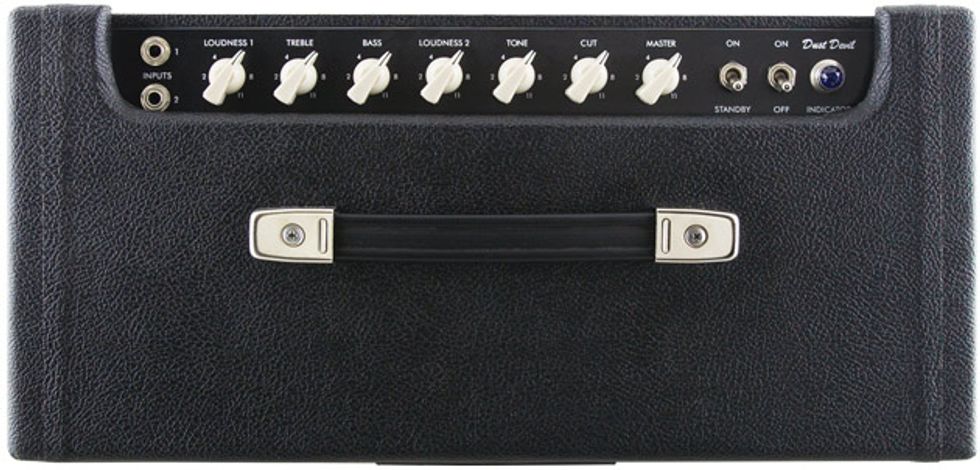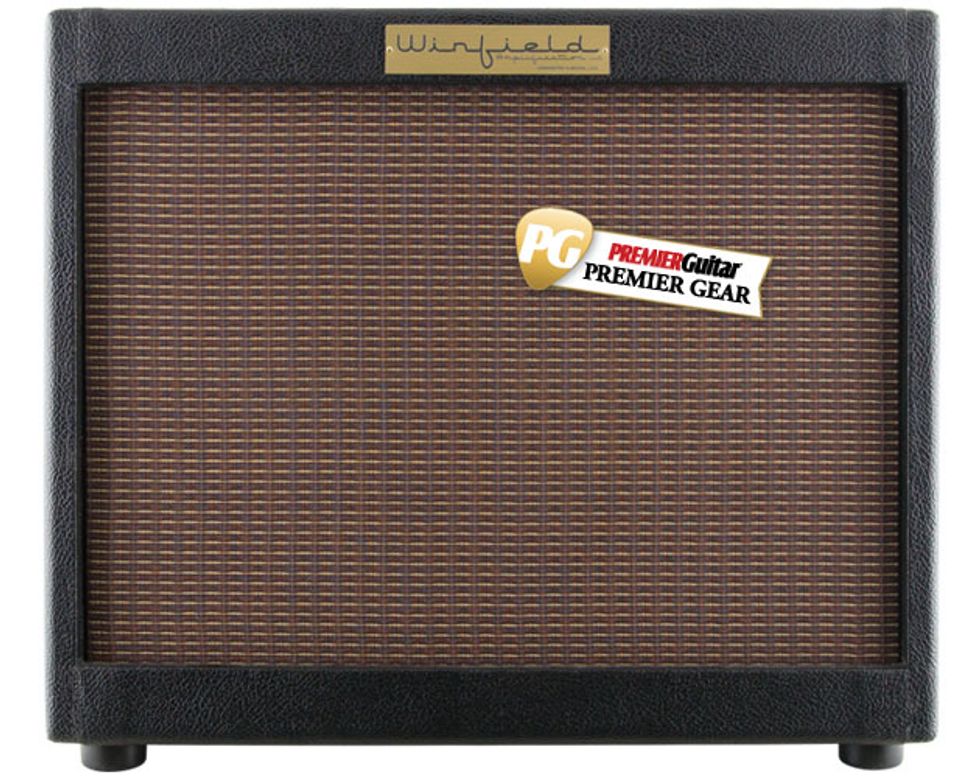The 2-channel, 15-watt, 1x12 Winfield Dust Devil is a beguiling piece of gear in the most complementary sense of the word. Outwardly, it looks rooted in the Fender firmament. (Indeed, it would be hard for any player with a sensitivity to style or sound signifiers to plug in without expecting some version of tweed Deluxe growl and squish.) Yet the twin EL84 heart of the Winfield Dust Devil is mostly Vox derived.
Dig deeper and the surprises become even more manifold. Channel 1, for instance, mates a Top Boost AC15-inspired power and preamp section with a blackface-style tone stack to create what Winfield calls the American-style channel. Yet channel 1 is much brighter and Vox-y sounding than the allegedly “British” channel 2, which sounds positively tweed-like by comparison.
Follow all that? Don’t worry if you don’t. The Dust Devil sounds awesome, and if you can’t get a cool sound out of this amp, you might want to pack it up and study kazoo.
Looks Can Deceive
If you’re perplexed by the Brit-in-Yankee’s clothing that is the essence of the Dust Devil’s style and sound, the control set can compound the mystery—at least at first. A push-pull master volume works for both channels, but is removed from the circuit in the “down” position. The AC15-style treble and bass controls, in fact, comprise the blackface-style tone stack. Meanwhile, the very Fender Deluxe-like single tone control on channel 2 regulates what Winfield says is a more AC15-like output. Regardless of intent, both tone controls are effective and rangy.
The tone controls on both channels are complimented by the post-phase inverter treble cut control, which regulates high-end output from the output section rather than at the preamp. It’s somewhat counterintuitive as a “cut” control because rotating it clockwise actually adds high end (the control’s position relative to the phase inverter means the knob effectively works backwards). Once you get used to the way treble cut works—and on the Dust Devil it’s a very sensitive control—it lets you dial in very precise tone profiles to suit different guitars and effects. It’s a process that takes practice, but which can be invaluable when you switch between, say, a Stratocaster and a Les Paul, use an outboard gain device, or employ guitar controls to fine tune your output.

Each channel has its own volume control, which becomes doubly cool when you use an A/B switch between channels. Alas, Winfield does not include such a switch, but it’s an excellent, minor investment that really opens up the possibilities of this amp.
Dusty Does Dirty
Our hats off to Winfield for crafting two channels that sound and feel so very different, yet share the same power section. Channel 1, though pitched by Winfield as the more “American” channel, is brash, bright, and very, very Vox-like. A Stratocaster bridge pickup paired with this channel will deliver some of the sweetest and nastiest rock rhythm tones you’ve ever heard. It’s the kind of tone that works for everything from ’60s jangle and Oh Sees-style garage punk to funk and angular art-punk textures. There’s a fine line between sweetness and ear-singeing here—just a bit too much treble can transform that Stratocaster bridge pickup from sassy to intolerably scathing. But it’s a great match for a wooly humbucker and it’s the kind of sound I would love to use aggressively in a studio where you can attenuate treble in a mix. Put simply: You’ll never have too little high end if you use Dust Devil’s channel 1.
Ratings
Pros:
Very versatile 2-channel design that delivers unique shades of Vox- and Fender-style tones. Exceptionally responsive and dynamic.
Cons:
Channel 1 can be too brash with single-coils. Does not include channel-switching footswitch.
Tones:
Ease of Use:
Build/Design:
Value:
Street:
$1,700
Winfield Amplification Dust Devil
winfieldamps.com
Channel 2 (which is based very closely on Winfield’s Cyclone amp) is supposed to be closer to a classic AC15—and with those two EL84s, the tone cut control, and the Celestion Alnico Blue speaker it’s certainly got the guts to live in that guise. But to my ears, channel 2 often sounded and felt positively tweed-like—dishing Crazy Horse and James Gang filth and sag when master volume and channel volume controls were wide open, and rootsy, clean-verging-on-dirty tones with output controls in more intermediate zones. Perhaps it’s the presence of the EF86 preamp tube and 5AR4 rectifier tube in this channel circuit (old AC15s use a 12AX7 and GZ34 respectively). But there is something very different in the tone and feel of channel 2 that bridges Vox and Fender lands with rambunctious grace.
The Dust Devil always verges on dirty—at least at volumes that would make the amp useful in a rocking band. (And yes, it’s more than loud enough!) So getting the cleanest tones from the Dust Devil requires a willingness to get twiddly with your guitar volume knob. The good news is that the Dust Devil is fantastically responsive to input from guitar volume and tone controls. Moving the volume control on a Stratocaster between 8 and 3 yielded myriad shades of progressively cleaner—but still substantial—tones when I kept the master and channel volumes at maximum. On channel 2 in particular, volume-attenuated tones were a bit of power-pop and jangle-rock heaven. And the sensation of moving from these tones to crushing lead and rhythm sounds with a flick of your finger is thrilling. Chances are, you’ll be using fewer gain pedals if you put the Dust Devil to use in this way.
One aspect of the Dust Devil’s name that does not deceive: It’s a dry amp—there’s no reverb or tremolo. And the inclusion of one effect or the other for the $1,700 price would be nice. Then again, the Winfield sounds so fundamentally good that inexpensive tremolo and reverb pedals (I tested this with an unmodified Boss TR-2 and an Electro-Harmonix Holy Grail) sound fantastic. My guess is that few players will be distracted by any minor shortcomings associated with cheap-but-good reverb or tremolo pedals as they bathe in the Dust Devil’s enveloping output.
The Verdict
The Dust Devil is a classy, well-crafted, and creatively recombinant distillate of classic circuitry and sounds. It delivers on promises to provide bright Anglo chime and American rumble, but will serve up a thousand shades between the two if you’re creative and resourceful. I wouldn’t hesitate to make a whole record with this amp alone. And experiencing its dynamic aggression and timbral nuances at performance volume is positively exhilarating.















![Rig Rundown: Russian Circles’ Mike Sullivan [2025]](https://www.premierguitar.com/media-library/youtube.jpg?id=62303631&width=1245&height=700&quality=70&coordinates=0%2C0%2C0%2C0)




